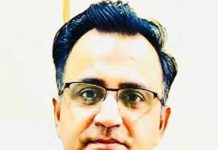Education is a journey of human being to acquireknowledge and superintendence about unknown, black holed and Bermuda triangular concepts of diversed nature objects and universe from literary enriched scholars at different stages of academia. Formal and informal educations accreditusto understand the human behaviour about religion, social, economic and diplomatic deeds duringhis life span. Education plays an imperative role to build-up the psyche of a nation about decision making towards that how they can chase theso- called rat racing aims and targets as 4th SDG switches our attention towards this 21st century’s burning debacle to ensure inclusive, equitable quality education and promote life-long learning opportunities for all.Pakistan is basically an agrarian economy having diverse natured demographics occupying 7, 960, 95 sq km area. Territory based division of area is Punjab, Sindh, KPK, Balochistan, Azad Kashmir and Gilgit Baltistan respectively. Provinces are united and governed as per the rules of 1973 constitution and further supplementary amendments are passed by the parliament and senate. Number of developmental programs had been launched and implemented by the Federal Government likethe National Plan of Educational Development-1951/57, National Literacy Plan-1984/86,Seventh Five Year Plan-1988/93 and Eighth Five- Year Plan 1983′ and Nationwide Literacy Programme(NaiRoshniSchools), 1986-90 and for assessment and evaluation ‘Iqra Pilot Project, 1986-89′ had also been framed.To raise the literacy and numeracy level across the country,’Literacy and Mass EducationCommission, 1981’ was established to meet the targets at the National level.11th amendmentof the constitution of Pakistan 1973 was amended in 2010 and each province has been empowered about policyframeworks and implementation of their decisions as per the direrequirement of their communities. Three types of educational system i.e. English medium schoolings and Urdu medium schooling and Danni Madras are functioning in Pakistan at the same time. Each educational system has its own pros and cons intuitively.Our education system is usually divided into six levels. The SOPs of educational institutions are enforced by the provincialgovernment, local bodies, and private management from lower to higher levels. Public and private sector Universities both are the stakeholder towards Instructional Technology (IT) and Business Education meanwhile agriculturalcolleges and medical colleges are also up-graded having equivalent status of universities.Cornerstone of the PTI’s 2018 electoral campaign, splitting the Punjab province politicalagenda got hype andreverberated the mindset of inhabitants of Punjab province.After 2018 Election, PTI-led government takeover the power in Punjab,KPK province and federal level respectively.After the birth of south Punjab province havingthree administrative divisions – Multan, Bahawalpur and Dera Ghazi Khan and subsequently 11 districts: Multan, Khanewal, Lodhran, Vehari, Dera Ghazi Khan, Muzaffargarh, Layyah, Rajanpur, Bahawalpur, Rahim Yar Khan and Bahawalnagar. The 5th new proposed province Saraikistanbelongs to saraiki nationalists embedded in southern and western Punjab belt. Territory-based and population density of Saraikistanconstitutes 52% covered land area of Punjab and 32% respectively.According to population census statistics, South Punjab population is on record scale up to 34,743,590.Round about 35%(3.5 billion rupees)of Punjab government budget will be reserved for the establishment of Secretariat institutional infrastructuredevelopment of Southern Punjab’s Province and 1,350 appointments will be sanctioned to uplift the livelihood of inhabitants and socio-economic indicators in the region.The southern region has also allocated more shares by sector, namely school education 53% &health 39%. Due to pandemic, disruption occurredin the educational activities,80 million rupees fund was allocated for the TaleemGhar Initiative to identify the missed school learning outcomes andcurriculum content development for distance learning and strengthening the digital infrastructure.Regarding out-of-school children, development budget of 393 billion rupees has been provided to the education department for the rehabilitation of the existing infrastructure and to take innovative measures like “Insaf School Program” leads to increase literacy rate and numeracy.Fiscal surplus of the fiscal year(2019-20) has been set aside 233 billion rupees, which will be utilized to reduce the national budget deficit along with aiming to chase the revenue targets for the upcoming fiscal year.Literacy rate varies region wise and gender wise in Pakistan. The literacy rate ranges from 85% in Islamabad Whereas in tribal zones, the female literacy rate is 9.5% and Azad Jammu & Kashmir is 74%.Pakistan is enlisted as a country with the second largest school population (22.8 million children).Pakistan’s universities produces approximately 445,000 university graduates and 80,000 computer science graduates each year. In Punjab province, 14 new established universities are receiving 35% share from educational budget 2020.According to Higher Education Commission report,there are 11 HEC-accredited universities in the Saraki region, and meanwhile Lahore alone has 16 HEC-accredited universities.14 new universities will be established, including 9 universities in the southern Punjab Province.In the federal budget for fiscal year(2019-20),Rs 77.262 billion has been earmarked for the Education Affairs and services against the revised allocation of Rs 97.155 billion for the current fiscal year indicating a decreasing trend of approximately 20.5 percent. The government has reduced the budgetary allocation quota towards higher education sector. Pakistan’s public expenditure on education (%age of GDP) is to be estimated 2.4% during the fiscal year(2018-19). HEC put forward the demand draft of Rs 55 billion under the PSDP for 2019-20 While Rs 28.646 billion has been earmarked for HECincluding Rs 25.777 billion for ongoing and Rs 2.869 billion for new schemes. The allocation for the new projects proposed by “Task Force on Technology Driven Knowledge Development” is Rs 4.297 billion under the PSDP for 2019-20.Education Affairs and Services, Tertiary Education Affairs and Services,Pre-primary and Primary Education Affairs, Secondary Education Affairs and Services, Tertiary Education Affairs and Services and for administrationhas been allocated Rs 77.262 billion and Rs 65.233 billion,Rs 2.831billion, Rs 6.718 billion ,Rs 65.233,Rs 1.407 billion respectively for 2019-20. In the previous budget, Rs 42.4 billion were allocated for higher education sector which constitutes Rs 35.1 billion to meet the current expenditures and Rs 7.3 billion for development purpose. Further redistribution channel exerts the blue print of expenditure including Rs 2.12 crore was reserved for the construction and completion of 64 new colleges in the province, Rs 15.4 crore was invested for the reconstruction of 51 universities, Rs 540 crore was allocated for the Chief Minister Merit Scholarship Program.
The graph explains that minimum and maximum range of Education spending (% of GDP) was recorded on scale since 1972 (1.58 %) and 1997 (3.02%) respectively whose average value during (1972-1997) was 2.36%.Pakistan’s Education spending (% of GDP) is 2.9%(2017) and compared it with world average (2017).The success of a Govt. can be monitored and judged by the public through different socioeconomic indicators performance like Education, Health, Rule of law, Good governance, price mechanism of markets, Foreign exchange reserves, devaluation and revaluation scenario, BOP, availability of employment opportunities, circular debt, economic growth etc.It will becomestrident for the government to cope up with the desired wishes of general public and expected productive and non productive budgetary outlays to rehabilitate the southern Punjab province on its toe administratively as well as onfinancially edges. Here below the blue-print of newly province.
Sign in
Welcome! Log into your account
Forgot your password? Get help
Password recovery
Recover your password
A password will be e-mailed to you.




